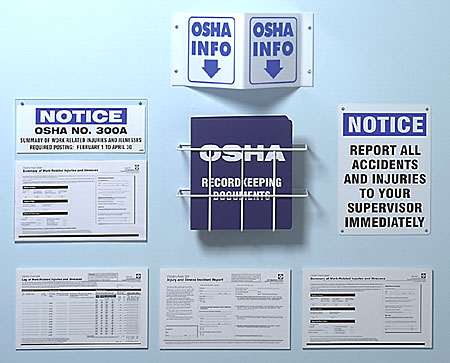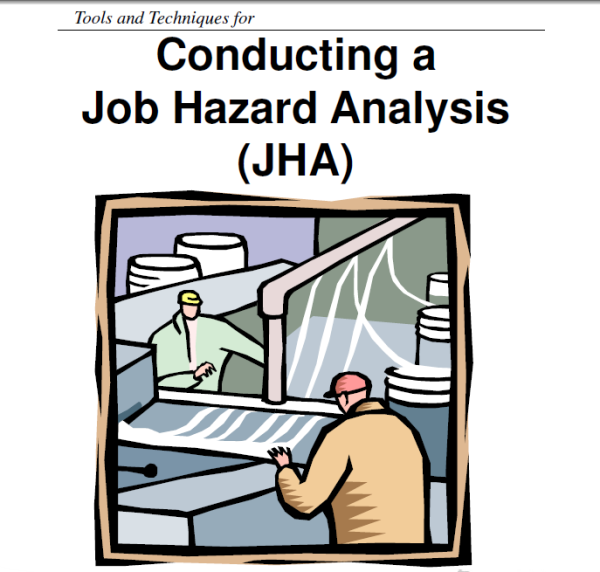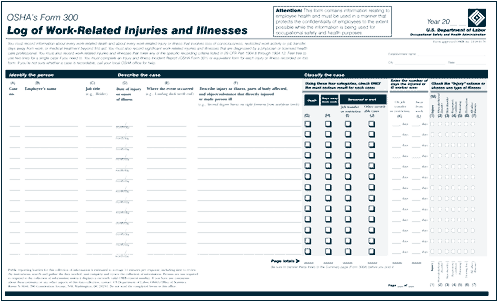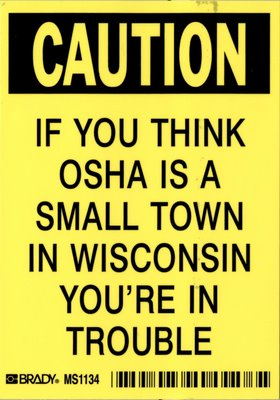Posted by Dan Phelan on Thu, Jun 02, 2011 @ 07:43 AM
If you have a workplace incident and you are questioning whether it's an OSHA recordable, OSHA has developed a website with an easy yes/no question system to help you figure it out. Some details on how it works are below as well as here
And please, if an injured worker is bleeding badly, unconscious, or has an obviously serious injury, please call 911 and apply first aid prior to seeing if it is OSHA recordable.
If you want to read any of our other blog posts about OSHA regulations, preventing OSHA visits, and OSHA 300 recordkeeping, they're available here:
Construction Risk Blog OSHA Posts

New Web tool helps employers understand OSHA recordkeeping rules
The OSHA Recordkeeping Adviser is a new Web tool that helps employers understand their responsibilities to report and record work-related injuries and illnesses under the Occupational Safety and Health Administration's regulations. A set of questions assists in determining quickly whether an injury or illness is work-related, whether it needs to be recorded and which provisions of the regulations apply.
More Info From OSHA's Website:
The Occupational Safety and Health Administration (OSHA) of the Department of Labor has developed this elaws Advisor to address the federal requirement to report and record work-related injuries and illnesses. The OSHA Recordkeeping Advisor is intended to help determine:
- Whether an injury or illness (or related event) is work-related
- Whether an event or exposure at home or on travel is work-related
- Whether an exception applies to the injury or illness
- Whether a work-related injury or illness needs to be recorded
- Which provisions of the regulations apply when recording a work-related case
The OSHA Recordkeeping Advisor presents questions and relies on responses to determine the appropriate course of action. The Advisor does not store any information. If the Advisor does not address the circumstances of a particular case, please contact OSHA or obtain expert advice.
Some employers may be exempt from OSHA’s recordkeeping rules, for example those with 10 or fewer employees during the previous calendar year and those classified in specific industries. If you are unsure whether your company or business is covered by the requirements, please see, OSHA’s regulations at 29 CFR 1904.1, Partial exemption for employers with 10 or fewer employees; 29 CFR 1904.2, Partial exemption for establishments in certain industries; and 29 CFR 1904.3, Keeping records for more than one agency; and Appendix A (the list of industries). Employers in States with OSHA-approved State plans should contact their States for information on State-specific exemptions. In addition, public sector employers in these States are subject to State recordkeeping regulations.
While using this Advisor, please remember that you should treat incidents such as any cut, laceration, needlestick, splash with bodily fluid, or exposure to tuberculosis as an injury or illness. (The Advisor addresses “privacy concern cases” as needed.) Furthermore, a Standard Threshold Shift (STS) in hearing in one or both ears, any significant diagnosed injuries and illnesses, and cases involving medical removal under an OSHA standard should be considered injuries or illnesses for the purposes of this Advisor.
The OSHA Recordkeeping Advisor is written in plain language and intended to assist employers, especially small business employers, in understanding their recordkeeping requirements under OSHA regulations. It is not, however, a substitute for the OSHA Recordkeeping Rules 29 CFR 1904, the OSHA Recordkeeping Handbook or for the OSHA Recordkeeping Related Letters of Interpretation. For those who wish to read exact regulatory language, links are provided throughout the Advisor where appropriate.
Posted by Debbi Kuhne on Wed, May 18, 2011 @ 01:36 PM
"The Bureau of Labor Statistics estimates that approximately 3.3 million serious work-related injuries and about 4,300 fatalities occurred in 2009. The human cost of preventable workplace injuries and deaths is incalculable. However, according to the 2010 Liberty Mutual Workplace Safety Index, the direct cost of the most disabling workplace injuries and illnesses in 2008 amounted to $53.42 billion in U.S. workers compensation costs, more than one billion dollars per week. This money would be better spent on job creation and innovation. Injury and illness prevention programs are good for workers, good for business and good for America." - Dr. David Michaels Assistant Secretary of Labor
Does your construction company have an Injury Prevention Program, or do you just wait until an employee is injured? It is possible to prevent every injury, you just need to have a program in place and monitor it regularly.
OSHA has just released a new web page with east to use guides on how to implement an effective system for finding and fixing workplace hazards. Addressing the hazards before an accident occurs should be your #1 goal.
Most successful injury and illness prevention programs are based on a common set of key elements. These include: management leadership, worker participation, hazard identification, hazard prevention and control, education and training, and program evaluation and improvement.
You can access OSHA’s new web page at http://www.osha.gov/dsg/topics/safetyhealth/index.html
Posted by Dan Phelan on Thu, Apr 07, 2011 @ 08:43 AM
A former construction foreman has been charged with four felony counts in connection with a 2008 construction accident.
April 07, 2011 /24-7PressRelease/ -- In the same way that a drunk driving accident may result in criminal (DUI) charges as well as civil claims (for property damage or injuries caused in the accident), worksite accidents may also give rise to both criminal charges and civil claims for damages.
A recent case out of San Luis Obispo County is a perfect example where both civil and criminal consequences arose out of a construction accident. A construction site foreman was charged with two counts of involuntary manslaughter and two counts of violating the Labor Code in connection with a worksite accident in 2008 that resulted in the death of two men.
Criminal Charges
Two workers were removing struts from a pipe laid in a trench when an excavator working on another section of the trench reportedly struck a city water line. Both workers were trapped in the trench, and drowned.
According to the San Luis Obispo Tribune, the foreman instructed the workers to continue digging even though he had been warned that there was a water line in the excavation area. Investigation documents indicate confusion whether there were utility lines, reported the New Times. The foreman told investigators that he may have looked at a site map upside down, not seeing the water line marking, or that he may have relied on an unmarked map.
He now faces a total of six years and four months in jail if convicted of all four felony charges.
Civil Settlement and Fines
Criminal charges were not filed against the construction company; instead, the District Attorney sought and the company has agreed to pay monetary and safety reform. The construction company has agreed to pay $3 million, which will be divided among San Luis Obispo County, the California District Attorneys Association and the City of Paso Robles. The company will also adopt new safety procedures to improve employee safety at its excavation sites.
According to a company vice president, other settlements outside of court were also made with the families of the victims.
The company is appealing two $70,000 fines levied against it in early 2009 by the Division of Occupational Safety and Health (better known as Cal/OSHA) for a serious and willful violation.
Recourse When Workers are Injured
While not every construction accident results in both criminal and civil consequences, injured workers still have the right to pursue compensation for their injuries -- in some instances pursuing damages against those whose negligence caused the worksite accident.
When a worker is injured in a construction-related accident, there are various types of recourse, including:
- Workers' compensation: Injured employees can file an administrative claim with the workers' compensation insurance for money for medical bills and lost wages
- Court settlement or litigation: Injured workers can file a civil action to pursue money damages
- Civil fines and penalties: State, federal or local agencies and entities may impose fines and penalties on the employer for safety or other violations.
- Criminal charges: The employer, or individual supervisors or co-employees, may face criminal charges when their role in the accident is so egregious as to rise to the level of criminal responsibility.
Not all recourse against the employer directly affects injured workers or their families. That is, civil fines or criminal charges are generally used to punish the employer, or as a basis for educating the employer and correcting the dangerous conditions that gave rise to the accident.
On the other hand, workers' compensation benefits are paid directly to the injured worker. Similarly, if a worker brings a courtroom action against the employer or supervisor, to the extent a jury award or court settlement is reached, that money would be paid directly to the injured worker. Verdicts and settlement money is used to compensate for medical expenses or loss of wages.
Jury awards can also be used to punish employers if the employer acted willfully, committed gross negligence or acted in disregard of humanity. In these instances, the court may impose punitive damages, which are awarded to the victim even though the purpose is to punish the employer.
Any workers who have suffered an illness or injury due to a workplace accident should contact a personal injury attorney to determine whether they have a claim for damages and to protect their right to claim those damages.
Article provided by Shapiro, Galving, Shapiro & Moran, PC
Visit their site at www.tadshapiroinjurylawyer.com
Posted by Dan Phelan on Tue, Apr 05, 2011 @ 08:31 AM
US Labor Department's OSHA cites homebuilder DR Horton and 4 subcontractors for fall hazards at Parker, Colo., construction site
DENVER (MMD Newswire) April 4, 2011 -- The U.S. Department of Labor's Occupational Safety and Health Administration has cited homebuilder D.R. Horton of Greenwood Village, along with four subcontractors, for safety violations resulting from a fall hazard inspection at a Parker worksite. Proposed penalties for all employers at the worksite total $93,640.
"D.R. Horton failed to properly manage a residential project jobsite by allowing subcontractor employees to be exposed to serious fall hazards," said John Healy, OSHA area director in Englewood. "This employer is well aware of the requirements for fall protection and has been cited several times for similar infractions."
D.R. Horton currently is being cited with one repeat violation of OSHA's residential construction fall protection standard for failing to protect workers from falls during framing and sheathing. The proposed penalty is $70,000. The company was cited for similar hazards in April and September of 2006 in Colorado. A repeat violation exists when an employer previously has been cited for the same or a similar violation of a standard, regulation, rule or order at any other facility in federal enforcement states within the last five years.
Denver-based subcontractors Kellory & Co. Inc., Webb Construction Inc., Dain Construction Inc. and LBR Construction Inc. are being cited with repeat and serious violations carrying a combined proposed penalty of $23,640. The alleged violations relate to a lack of fall protection during framing and sheathing, and inadequate training on the use of forklifts. A serious violation occurs when there is substantial probability that death or serious physical harm could result from a hazard about which the employer knew or should have known.
Detailed information about fall hazards and safeguards is available on OSHA's website at http://www.osha.gov/SLTC/fallprotection/construction.html.
The companies have 15 business days from receipt of the citations and proposed penalties to comply, request an informal conference with OSHA's area director or contest the findings before the independent Occupational Safety and Health Review Commission. The inspection was conducted by OSHA's Englewood Area Office; telephone 303-843-4500. To report workplace incidents, fatalities or situations posing imminent danger to workers, call the agency's toll-free hotline at 800-321-OSHA (6742).
Under the Occupational Safety and Health Act of 1970, employers are responsible for providing safe and healthful workplaces for their employees. OSHA's role is to ensure these conditions for America's working men and women by setting and enforcing standards, and providing training, education and assistance. For more information, visit http://www.osha.gov.
Does your construction company have an extra 70K available to pay an OSHA fine? If not, compliance should be your #1 priority. Not just for the safety of your workers and their families, but also for the financial safety of your firm.
Posted by Debbi Kuhne on Wed, Mar 09, 2011 @ 01:36 PM
Part 1 Here
 So, every day we hear of another construction site being visited by an OSHA inspector……all to review OSHA logs and data! It appears this is number one on OSHA’s radar screen and could end up costing Connecticut contractors big bucks!
So, every day we hear of another construction site being visited by an OSHA inspector……all to review OSHA logs and data! It appears this is number one on OSHA’s radar screen and could end up costing Connecticut contractors big bucks!
The two areas on the OSHA logs that it appears are being targeted are the Location and the Injury Description. Although for many years, most everyone has merely used job numbers for the location, it appears that OSHA is looking for a lot more information. An OSHA employee recently told us that area should be specific, i.e. 2nd floor of condo building, unit 22A, kitchen. A little more than just job#C156!
More than likely your entries in the Injury Description area have been “broken ring finger” or “Burn to left hand”. Again, OSHA is looking for much more a description then just the body part. They want the when, how, etc. An example would be “employee was securing light fixture in ceiling when slipped out of hand, striking and breaking finger”. Pretty detailed, but at this point it looks like the more information you enter the less likely you are to be fined!
So, we suggest you beef up the information you enter and hopefully you will avoid the New Sheriff.
Posted by Debbi Kuhne on Tue, Feb 15, 2011 @ 12:58 PM
Were almost identical to the Top 10 OSHA Violations for 2009!
1. Scaffolding
2. Fall protection
3. HazCom
4. Ladders
5. Respiratory protection
6. Lockout/Tagout
7. Electrical Wiring
8. Powered Industrial Trucks
9. Electrical Systems design
10. Machines
 The top 10 list changes little from year to year. It appears this is an area where we haven’t learned from our mistakes. It’s time to start paying attention and not continuing to make the same mistakes over and over.
The top 10 list changes little from year to year. It appears this is an area where we haven’t learned from our mistakes. It’s time to start paying attention and not continuing to make the same mistakes over and over.
Safety should be your number one priority! Not just to avoid an OSHA violation or keep your Experience Mod under a 1.00! You want to make safety your number one priority to assure that your employees leave their workday in the same physical condition (with all the same body parts) as they arrived.
A good place to start is to conduct regular reviews of equipment and procedures with employees. Are safeguards in place? Do employees understand how and when to use the equipment? Is there a policy in place for disciplining those who decide to “take short cuts”?
Awareness is the key to workplace and construction jobsite safety and you can involve every employee in your program. Let’s see if we can make a difference in the top 10 for 2011!
Are you a Connecticut contractor that might need some assistance to get your staff up to date on OSHA training and fine prevention? Maybe you'd like a second set of eyes to make sure that your jobsites are compliant with OSHA regulations?
Request a Consultation with one of CRA's Risk Advisors.
Posted by Debbi Kuhne on Mon, Jan 31, 2011 @ 08:18 AM
 It’s 2011 and apparently the year of OSHA! Compliance officers will be out there more and more and we wouldn’t be surprised if they soon were showing up at businesses just to see if you have posted your 300A.
It’s 2011 and apparently the year of OSHA! Compliance officers will be out there more and more and we wouldn’t be surprised if they soon were showing up at businesses just to see if you have posted your 300A.
The posting requirement is from February 1st through APRIL 30TH each year.
If OSHA shows up at your doorstep, they will be asking to see your posted 300A and your OSHA logs, as well as copies of your First Reports of Injury. The OSHA log in itself has caused a lot of activity for our clients. OSHA is now requiring a detailed description of the incident, the location and the “cause”; and we do mean detailed. Gone are the days of “slipped and fell”. The specific location, what he/she slipped on, what caused him/her to slip, etc. The more details, the better!
For those with multiple locations, and especially contractors with multiple jobsites, be aware. If you are at a location other than your main one for 365 days or more you are required to keep a separate log of the incidents for that location along with posting the site specific 300A summary.
So a word of warning…. Make sure your OSHA logs are in order (details, details), you have all First Reports of Injury (or 301 forms) to support the log information and post that 300A summary!
If you need additional forms, they can be found on OSHA's Website.
If you need help completing your logs or have any other questions on OSHA compliance, give us a call at 1-800-252-9864
Posted by Debbi Kuhne on Mon, Dec 06, 2010 @ 08:29 AM
 Does your construction company use JHAs (Job Hazard Analysis’)? Or are you saying – “what’s the need; we know what the job is”? With OSHA increasing its activities and proposing increased fines along with your ongoing efforts to keep your experience mods as low as possible, one of the best tools you could be using are JHAs.
Does your construction company use JHAs (Job Hazard Analysis’)? Or are you saying – “what’s the need; we know what the job is”? With OSHA increasing its activities and proposing increased fines along with your ongoing efforts to keep your experience mods as low as possible, one of the best tools you could be using are JHAs.
A job hazard analysis should be performed by reviewing each task associated with a particular job. They help employers, foremen, supervisors and even individual employees recognize workplace hazards they might not have noticed otherwise. Recognizing and eliminating these hazards can help to reduce the possibility of workplace injuries in addition to increasing the productivity of your employees. Once the hazards are identified they can then be addressed and eliminated, adding extra training, or developing other company programs to reduce the hazard and/or the exposure to it.
With OSHA’s push for the recording of MSD (musculoskeletal disorders) on your OSHA 300 logs, JHAs may become even more important and helpful in identifying these particular hazards, and assist with designing of appropriate ergonomic remedies. Under the proposed OSHA regulation changes, all companies with MSD claims will be required to have company programs to implement full ergonomic programs.
Once again you can invest in your company by spending the extra time to review the job hazards and reduce the potention exposures or you can just start working and wait to suffer a Workers’ Compensation claim and/or OSHA fine. How would you prefer to spend your company’s dollars?
For help with establishing a JHA program you can begin by reviewing the OSHA JHA manual HERE
Posted by Debbi Kuhne on Mon, Nov 29, 2010 @ 01:37 PM
 "There's a New Sheriff in Town"was the statement made by Secretary of Labor Hilda Solis as she commented on the new commitment to worker safety and health. OSHA is increasing its emphasis on enforcement, proposing new changes and employers better get on board or be prepared to pay the fines!
"There's a New Sheriff in Town"was the statement made by Secretary of Labor Hilda Solis as she commented on the new commitment to worker safety and health. OSHA is increasing its emphasis on enforcement, proposing new changes and employers better get on board or be prepared to pay the fines!
The first step we have seen is the increased activity on reviewing contractor’s OSHA logs. If the recordkeeping isn’t being done properly they aren’t hesitating to enforce fines. Unfortunately just following the directions on the OSHA site isn’t necessarily fulfilling the requirements, at least not in the eyes of the inspectors.
OSHA logs. If the recordkeeping isn’t being done properly they aren’t hesitating to enforce fines. Unfortunately just following the directions on the OSHA site isn’t necessarily fulfilling the requirements, at least not in the eyes of the inspectors.
OSHA has proposed ergonomic recordkeeping requirements (yes, again). The proposal is to add the MSD injury column, as they attempted to once before. However, this time if the proposal goes through and you have an MSD injury on your log you had better also have a company ergonomics program in place as this will likely be a requirement. Without the ergonomics program where one is determined to be needed, employers may face “serious” or “willful” citations. No final decision has been made on this change to recordkeeping requirements but we suspect it’ll be coming in the first quarter of 2011.
Another proposal is that the fines levied on Connecticut contractors may be on the increase! Fines haven’t been increased in over 30 years and there is a bill pending that would increase the maximum “serious” penalty from $7,000 to $12,500 and the maximum “willful” penalty from $70,000 to $250,000! Aside, from the pain in your wallet, consider what this could do to your Risk Profile next time your Connecticut construction insurance renews!
List of Top 10 Citations for Contractors
So, where do you start? All jobs and jobsites should have JHAs (download the OSHA Job Hazard Analysis) performed regularly. This will provide information to you as an employer of where MSD injuries might occur (as well as all other types of injuries) and will give you a “heads up” of where programs and additional training may need to be established. The more programs and training you have in place, the less likely you are to have a recordable incident! Better to invest your company dollars in these then paying substantial fines to OSHA!
Stay tuned….we’ll be updating you more in the coming months on the “New Sheriff”!
Posted by Debbi Kuhne on Thu, Sep 23, 2010 @ 08:32 AM
Many years ago OSHA issued a list of 14 items that qualify as First Aid. If the incident required only the First Aid treatment, the case did not need to be recorded. Yet I still see commercial contractors that are listing everything on their OSHA Logs. Just because an employee visits the occupational health clinic for a workers compensation claim, does not make it an OSHA recordable case!
 The 14 items that OSHA considers First Aid are:
The 14 items that OSHA considers First Aid are:
1. Using non-prescription medications at non-prescription strength (i.e. over the counter Motrin)
2. Administering tetanus immunizations
3. Cleaning, flushing or soaking wounds on the skin surface
4. Using wound coverings, such as bandages, gauze pads, butterfly bandages, etc.
5. Using hot or cold therapy
6. Using any totally non-rigid means of support, such as elastic bandages or wraps
7. Using temporary immobilization devises while transporting injured employee (splints, slings, neck collars)
8. Drilling a fingernail or toenail to relieve pressure, or draining fluids from blisters
9. Using simple irrigation or a cotton swab to remove foreign bodies not embedded in or adhered to eye
10. Using eye patches
11. Using irrigation, tweezers, cotton swab or other simple means to remove splinters or foreign material from areas other than the eye
12. Using finger guards
13. Using massages
14. Drinking fluids to relieve heat stress
So, before just adding another case to your OSHA Log, check to make sure it is really a recordable incident. If you really aren’t sure whether to enter a case on your Log or not check it out at www.osha.gov and click on R for Recordkeeping. This will take you through the steps to determine if a case is recordable or not!
We also know a couple of great risk advisors that can also help you sort out your OSHA recordables ;)